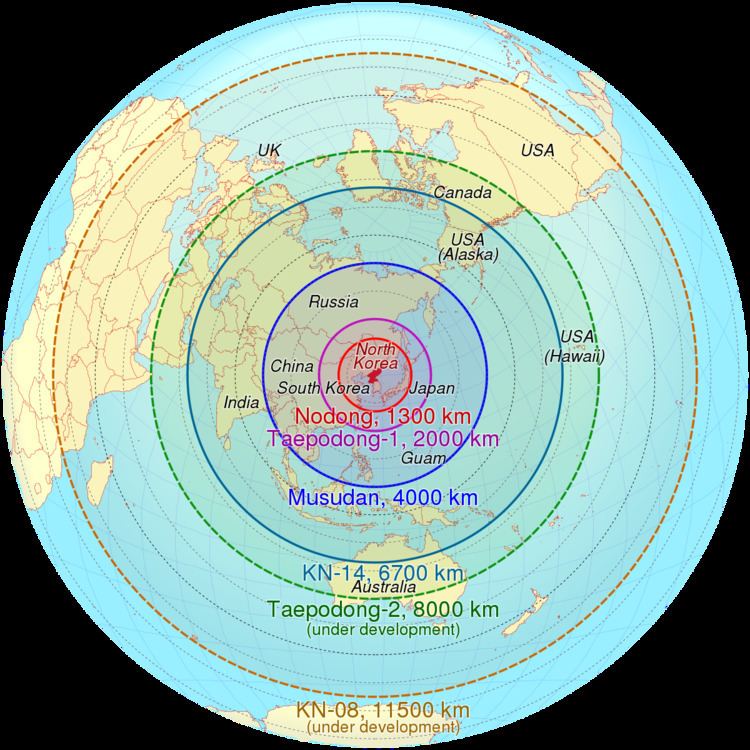Diameter 1.5m | Length 12m | |
 | ||
In service Successful test on 22 June 2016 Used by North Korea, possibly Iran | ||
The Hwasong-10 (Chosŏn'gŭl: 화성 10; hancha: 火星 10), also known by the names BM-25 and Musudan (Chosŏn'gŭl: 무수단; Hancha: 舞水端), is a mobile intermediate-range ballistic missile developed by North Korea. Hwasong-10 was first revealed to the international community in a military parade on 10 October 2010 celebrating the Korean Worker's Party's 65th anniversary, although experts believe these were mock-ups of the missile. Hwasong-10 resembles the shape of the Soviet Union's R-27 Zyb submarine-launched missile, but is slightly longer.
Contents
Development
In the mid-1990s, after the collapse of the Soviet Union, North Korea invited the Makeyev Design Bureau's ballistic missile designers and engineers to develop this missile, based on the R-27 Zyb.
It was decided that, as the Korean People's Army's MAZ-547A/MAZ-7916 Transporter erector launcher could carry 20 tonnes, and the R-27 Zyb was only 14.2 tonnes, the R-27 Zyb's fuel/oxidizer tank could be extended by approximately 2 metres. Additionally, the warhead was reduced from a three-warhead MIRV to a single warhead.
The actual rocket design is a liquid fuel rocket, generally believed to use a hypergolic combination of unsymmetrical dimethylhydrazine (UDMH) as fuel, and nitrogen tetroxide (NTO) as oxidizer. Once the fuel/oxidizer combination are fed into the missile, it could maintain a 'ready to launch' condition for several days, or even weeks, like the R-27 SLBM, in moderate ambient temperatures. A fueled Hwasong-10 would not have the structural strength to be safely land transported, so would have to be fueled at the launch site.
It was originally believed that the rocket motors of Hwasong-10 is made up the second stage of the Taepodong-2, which North Korea unsuccessfully test fired in 2006. However analysis of the Unha-3 launch, believed to be based on the Taepodong-2, showed that the second stage did not use the same fuel as the R-27, and is probably based on Nodong rocket technology.
Initially it was believed that there is a possibility that Hwasong-10 likewise is using the Nodong's kerosene and corrosion inhibited red fuming nitric acid (IRFNA) propellants, reducing the missile's range by about half.
However it is unlikely that North Korea uses IRFNA propellants which will reduce its range by about half, after the experts acknowledged that the June 22 twin test range could be at 3,150 km if the missile was not launched in the lofted trajectory.
Strategic Implications
According to the physics of ballistic missiles, North Korea have successfully tested a missile that could reach an apogee of 1,000 km to 1,413.6 km meaning that Hwasong-10 as an intermediate-range ballistic missile can be modified as an intercontinental ballistic missile.
Currently, North Korea is also working on land based nuclear deterrents that are of Intercontinental range, such as KN-08, KN-14 (Upgraded version of KN-08). It is also working a sea-based nuclear deterrent, such as KN-11 SLBM.
North Korea is confirmed to have successfully launched a KN-11 missile in a full test flight in a lofted trajectory and expecting KN-11 to be operationally deployed as early as before 2017 by South Korea military source in 25 Aug 2016.
Hwasong-10
Current operators
Suspected operators
Section 25 of this leaked cable (written before the 10 October 2010 appearance of the missile) says:
Russia said that during its presentations in Moscow and its comments thus far during the current talks, the U.S. has discussed the BM-25 as an existing system. Russia questioned the basis for this assumption and asked for any facts the U.S. had to provide its existence such as launches, photos, etc. For Russia, the BM-25 is a mysterious missile. North Korea has not conducted any tests of this missile, but the U.S. has said that North Korea transferred 19 of these missiles to Iran. It is hard for Russia to follow the logic trail on this. Since Russia has not seen any evidence of this missile being developed or tested, it is hard for Russia to imagine that Iran would buy an untested system. Russia does not understand how a deal would be made for an untested missile. References to the missile's existence are more in the domain of political literature than technical fact. In short, for Russia, there is a question about the existence of this system.
Given that Iran did not publicly display this missile system, there might be a chance that such transfer from North Korea did not happen at all.
